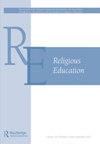A Pilgrimage to the Motherland: Understanding Pilgrimage Experience as Embodied Religious Education for Korean American Youth and Young Adults
IF 0.4
3区 哲学
0 RELIGION
引用次数: 0
Abstract
AbstractThis article explores how pilgrimage shapes the ways in which Korean American youth and young adults develop their sense of intersectional identities by visiting their motherland. The coauthors begin by highlighting the limitation of Korean American churches’ emphasis on text-based education, suggesting how pilgrimage as a spiritual practice could be more implemented for more embodied and experiential learning. By analyzing the Trip to the Motherland program run by the Presbyterian Churches in Korea and North America, the article demonstrates how transnational pilgrimage enables young pilgrims to gain a renewed sense of intersectional identities, which integrates their racial, ethnic, and religious lives.Keywords: Korean Americanpilgrimageembodied learningyoung adultsidentity development Disclosure statementNo potential conflict of interest was reported by the author(s).Notes1 The term “intersectional identity” comes from the concept of “intersectionality,” first coined by Kimberlé Crenshaw (Citation1989). Intersectionality describes how race and racism need to be understood at their intersection with other forms of indentification, such as gender, class, ethnicity, sexuality, immigration status, and more. This concept is helpful in exploring how Korean American young people often struggle to make sense of their racial, ethnic, cultural, and religious identities as racially minoritized individuals in America.2 Christine Hong and Anne Carter Walker (Citation2020) use a similar methodology in their co-written article. Inspired by bell hooks, Hong and Carter Walker use their personal narratives as a way to engage in critical dialogue and reflection on religious education and what it means to be religious educators as scholars of color. Patrick Reyes (Citation2018) also employs a similar approach in his article, “Practical Theology as Knowledge of Origin and Migration.”3 Cho participated in the pilgrimage in 2015 and 2018 and Han participated in the pilgrimage program in 2022.4 In the history of Korean Christianity, along with American Presbyterians, American Methodists also laid the Protestant Christian foundation in Korea, such as Henry G. Appenzeller, George Heber Jones, and Mary Scranton.5 Another similar program is called Brightright Israel, which provides opportunities for young American Jews to visit Israel on an all-expense-paid ten-day pilgrimage-tour. Sociologist and Jewish studies scholar Shaul Kelner (Citation2010) writes about the program and explores how it helps American Jewish young adults to think more extensively about their identities as they visit their motherland in Tours That Bind: Diaspora, Pilgrimage, and Israeli Birthright Tourism.6 While the transition into “Individuative-Reflective” faith ideally happens in the early to mid-twenties, Fowler (Citation1995) strongly indicates that not every young adult succeeds in doing it. Many people could also transition into this stage after their young adulthood.7 Yoido Full Gospel Church in Seoul is the world’s largest congregation with about 480,000 members.8 On May 3, 1984, Pope John Paul II visited this site to pay respect to the martyrs. He visited during the 200th anniversary of Catholicism in Korea. Mother Teresa visited the shrine a year later in 1985. On November 7, 1997, the shrine was designated as a site of national historical significance.9 But, Warfield also indicates that there are religious sites at which participants encounter possible disappointment with a sense of being underwhelmed. As a result, pilgrims might experience cognitive dissonance, which is the mental discomfort people feel when encountering conflicting experiences.10 The quotations from the interview with the participants come from the journalistic article Cho (Citation2017) wrote for Presbyterian Outlook.11 In his article (2020), Montague Williams, while he does not analyze pilgrimage as a developmental process, examines how a pilgrimage to Ferguson, Missouri in the aftermath of Michael Brown’s death enables young college students to embrace unity between spirituality and bodily engagement in social justice, and to engage in vocational discernment as a whole group of pilgrims.12 Woori as a Korean word for “we” or “us-ness.”Additional informationNotes on contributorsEunil David ChoEunil David Cho, School of Theology, Boston University School of Theology, USA. Email: eunilcho@bu.eduGaram HanGaram Han Garrett-Evangelical Theological Seminary, USA. Email: garam.han@garrett.edu祖国朝圣:对韩裔美国青年宗教教育具体化的朝圣体验的理解
摘要本文探讨了朝圣是如何塑造韩裔美国青年和年轻人通过访问祖国来发展他们的交叉身份感的。共同作者首先强调了韩裔美国教会强调基于文本的教育的局限性,建议如何将朝圣作为一种精神实践,更多地实施具体化和体验式学习。本文通过分析韩国长老会和北美长老会开展的“祖国之旅”项目,展示了跨国朝圣如何使年轻的朝圣者获得融合种族、民族和宗教生活的新的交叉身份感。关键词:韩裔美国人朝圣具身学习青少年身份发展披露声明作者未报告潜在利益冲突。注1“交叉身份”一词来源于“交叉性”的概念,该概念最早由金伯利·勒·克伦肖(Citation1989)提出。交叉性描述了种族和种族主义需要如何与其他形式的认同(如性别、阶级、种族、性取向、移民身份等)相交叉来理解。这个概念有助于探索韩裔美国年轻人如何经常努力理解他们作为美国少数种族个体的种族、民族、文化和宗教身份。2 Christine Hong和Anne Carter Walker (Citation2020)在他们共同撰写的文章中使用了类似的方法。受贝尔·胡克斯的启发,洪和卡特·沃克用他们的个人叙述作为一种方式,参与宗教教育的批判性对话和反思,以及作为有色人种学者的宗教教育家意味着什么。帕特里克·雷耶斯(Patrick Reyes, Citation2018)在他的文章《作为起源和迁移知识的实践神学》中也采用了类似的方法。“赵某在2015年和2018年参加了朝圣,韩某在2022年参加了朝圣项目。”在韩国基督教的历史上,美国卫理公会教徒和美国长老会教徒一起为韩国奠定了新教的基础,如亨利·阿彭策勒、乔治·希伯·琼斯、玛丽·斯克兰顿等。该计划为年轻的美国犹太人提供了访问以色列的机会,他们可以免费进行为期十天的朝圣之旅。社会学家和犹太研究学者Shaul Kelner (Citation2010)写了这个项目,并探讨了它如何帮助美国犹太年轻人在他们访问祖国的旅行中更广泛地思考他们的身份:散居、朝圣和以色列与生俱来的权利旅游。虽然理想情况下,向“个人反思”信仰的转变发生在20岁左右,但福勒(Citation1995)强烈指出,并不是每个年轻人都能成功做到这一点。许多人在成年后也会过渡到这个阶段首尔的汝矣岛完全福音教会是世界上最大的教会,拥有大约48万名成员1984年5月3日,教皇约翰·保罗二世参观了这里,向烈士们致敬。他在韩国天主教成立200周年之际访问了韩国。一年后的1985年,特蕾莎修女参拜了靖国神社。1997年11月7日,靖国神社被指定为具有国家历史意义的遗址但是,沃菲尔德也指出,在一些宗教场所,参与者可能会感到失望,感到失望。因此,朝圣者可能会经历认知失调,这是人们在遇到冲突的经历时感到的精神不适在他的文章(2020)中,蒙塔古·威廉姆斯(Montague Williams)虽然没有将朝圣作为一个发展过程进行分析,但他研究了迈克尔·布朗(Michael Brown)死后前往密苏里州弗格森(Ferguson)的朝圣如何使年轻的大学生能够接受精神和身体参与社会正义之间的统一。并作为一群朝圣者,参与圣召的分辨Woori是韩语单词,意思是“我们”或“我们”。关于贡献者的说明:美国波士顿大学神学院,神学学院。电邮:eunilcho@bu.eduGaram HanGaram Han Garrett-Evangelical Theological Seminary, USA。电子邮件:garam.han@garrett.edu
本文章由计算机程序翻译,如有差异,请以英文原文为准。
求助全文
约1分钟内获得全文
求助全文
来源期刊

RELIGIOUS EDUCATION
RELIGION-
CiteScore
0.90
自引率
28.60%
发文量
46
期刊介绍:
Religious Education, the journal of the Religious Education Association: An Association of Professors, Practitioners, and Researchers in Religious Education, offers an interfaith forum for exploring religious identity, formation, and education in faith communities, academic disciplines and institutions, and public life and the global community.
 求助内容:
求助内容: 应助结果提醒方式:
应助结果提醒方式:


